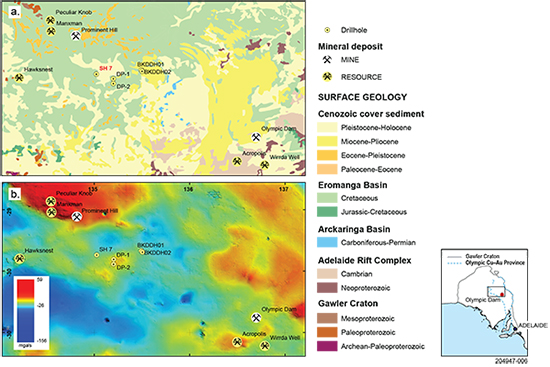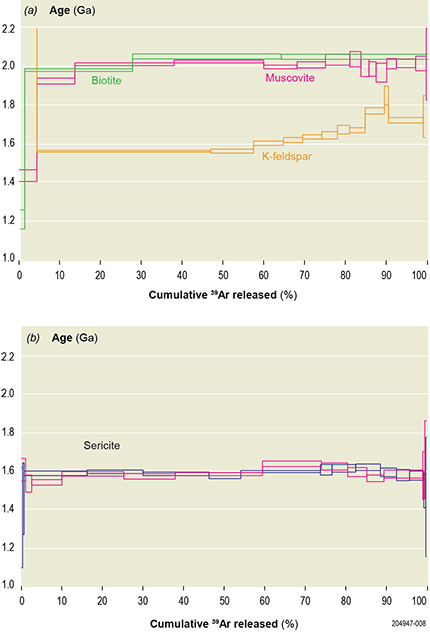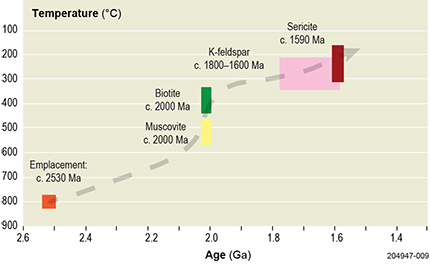Anthony Reid1, 2
1 Geological Survey of South Australia, Department of the Premier and Cabinet
2 Department of Earth Sciences, University of Adelaide
Download this article as a PDF (0.7 MB); cite as MESA Journal 84, pages 23–27
Introduction
Hydrothermal processes that precipitate ore minerals are very sensitive to the thermal state of the crust into which those hydrothermal fluids move. This is because changes in fluid chemistry caused by drops in temperature and pressure are important factors in formation of hydrothermal ore deposits (Lester, Ord and Hobbs 2012). The most extreme changes in temperature and pressure occur above the brittle–ductile transition, and typically within the upper 10 km of the crust, and it is the upper portions of a mineral system that are typically the most prospective. Being able to demonstrate that a particular rock mass was at low temperature and therefore shallow crustal levels during a known mineralisation event has implications for understanding the mineral prospectivity of a region.
For example, in hematite-rich iron oxide – copper–gold (IOCG) systems, ore-bearing fluids are typically in the order of 200 to 300 °C and result from the mixing of multiple fluid sources, often with an input of magmatic fluid with starting temperatures >600 °C (Williams et al. 2005). Therefore, one of the indicators of prospectivity for IOCG systems includes the preservation of shallow crustal levels from the time of the mineralisation event.
This article summarises recently published 40Ar/39Ar thermochronology that investigated the region of crust between the Olympic Dam and Prominent Hill mines within the Olympic Cu–Au Province of the eastern Gawler Craton (Reid, Jourdan and Jagodzinski 2017; Fig. 1). Both of these deposits and the region between them are covered by up to 500 m of Neoproterozoic to Cenozoic sediment, making inferences about prospectivity reliant on geophysical interpretation and sparse drillhole information. The study aimed to determine the thermal history of the Archean rocks to see if there was any evidence for thermal or alteration effects associated with the c. 1.59 Ga event that formed the majority of the IOCG mineralisation in the Olympic Cu–Au Province (Skirrow et al. 2007).
Figure 1 Location of drillholes sampled in the Reid, Jourdan and Jagodzinski (2017) study. (a) Surface geology at 1:100,000 scale. (b) Bouguer gravity image. Inset shows location of the study area with respect to the Gawler Craton and the Olympic Cu–Au Province. Geological and geophysical data available via South Australian Resources Information Gateway (SARIG). Reprinted from Reid, Jourdan and Jagodzinski (2017; figs 2a and 2b) with the permission of the Geological Society of Australia.
Geological setting
The Gawler Craton is a Mesoarchean to Mesoproterozoic basement province in South Australia that contains evidence for multiple stages of crustal reworking and rejuvenation (Hand, Reid and Jagodzinski 2007; Reid and Hand 2012). The Olympic Cu–Au Province is a region of IOCG ± U mineralisation and related alteration that occurs along the eastern margin of the Gawler Craton (Skirrow et al. 2002; Skirrow et al. 2007). The Gawler Craton basement within the Olympic Cu–Au Province comprises Neoarchean granite and volcanics (Devils Playground Volcanics) that have been intercepted in mineral exploration drillholes between Olympic Dam and Prominent Hill (Cowley and Fanning 1991; Reid, Fricke and Cowley 2009; Reid, Jourdan and Jagodzinski 2017). This basement is intruded and overlain by Paleoproterozoic metasedimentary and igneous units including granites of the c. 1.85 Ga Donington Suite and the c. 1.75 Ga Wallaroo Group (Jagodzinski 2005). A major igneous event occurred at c. 1.59 Ga with the intrusion of granites of the Hiltaba Suite and extrusion of bimodal volcanics of the Gawler Range Volcanics (Johnson and Cross 1995; Allen et al. 2008; McPhie et al. 2011). Alteration and mineralisation related to this major thermal event occurred throughout the Olympic Cu–Au Province (Skirrow et al. 2007; Ciobanu et al. 2013; Reid et al. 2013).
The Olympic Cu–Au Province is buried beneath a veneer of Neoproterozoic to Cenozoic sedimentary successions including those associated with the Adelaide Rift Complex, along with Mesozoic rocks of the Eromanga Basin.
Sampling strategy
Reid, Jourdan and Jagodzinski (2017) attempted to constrain the thermal history and the timing of fluid flow by applying the 40Ar/39Ar method to magmatic mica and K-feldspar and hydrothermal sericite in rocks from mineral exploration drillhole SH 7 located in the region between Olympic Dam and Prominent Hill (Fig. 1). SH 7 (SA Geodata drillhole number 227935) intersected a weakly oxidised and hematite-altered tonalite dated at 2.529 ± 0.005 Ga (Reid, Jourdan and Jagodzinski 2017) beneath 1,427 m of sedimentary cover sequences that include >1,000 m of Mesoproterozoic Pandurra Formation (Sawyer et al. 2009). The tonalite is variably hematite-altered, in places pervasively so, where iron oxide (hematite) is associated with sericite, chlorite and clays (Fig. 2). Biotite, muscovite, K-feldspar and sericite were dated from two samples of the tonalite via the 40Ar/39Ar method.
Analytical methods
The K-bearing mineral phases were analysed by the 40Ar/39Ar method (McDougall and Harrison 1999) at Curtin University within the Western Australia Argon Isotope Facility using the methods of Jourdan et al. (2010). The minerals were extracted via standard crushing and density separation, and hand-picked to concentrate high-purity separates. The samples were then irradiated in the US Geological Survey nuclear reactor (Denver, Colorado) to convert 39K into 39Ar, so that the parent and a proxy for the daughter isotope could be measured simultaneously. The samples were degassed in a high-vacuum mass spectrometer via a continuous wave Nd-YAG (IR; 1064 nm) laser rastered during 1 min over individual grains or multi-grain aliquots. This heating causes the crystal structure of the mineral to degrade and release the trapped Ar. More details of the analytical methods and the full analytical data tables are found in the original paper (Reid, Jourdan and Jagodzinski 2017).
Figure 2 Representative images of tonalite from drillhole SH 7. Abbreviations: bt, biotite; chl, chlorite; Ksp, K-feldspar; mu, muscovite; plag, plagioclase; qtz, quartz; ser, sericite; TiO, titanium oxide (leucoxene). Reprinted from Reid, Jourdan and Jagodzinski (2017; figs 4a, 4c, 4e and 4f) with the permission of the Geological Society of Australia.
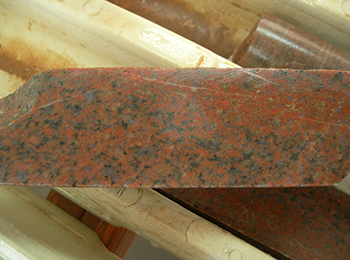
Figure 2a Moderately hematite-altered tonalite, 1,465 m. Drill core is 3.5 cm wide. (Photo 415922)
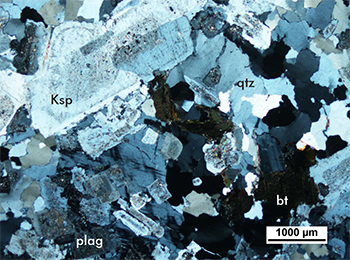
Figure 2b Photomicrograph of sample 1965413, 1,465.8–1,467.0 m, cross-polarised light showing K-feldspar and biotite within primary igneous texture of the tonalite. (Photos 415923)
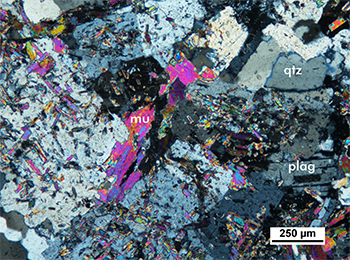
Figure 2c Photomicrograph of sample 1965411, 1451.5–1451.6 m, cross-polarised light. Muscovite occurs as both coarse (>250 µm) and smaller (<50 µm) flakes, the latter of which commonly occur as inclusions within plagioclase. (Photo 415924)
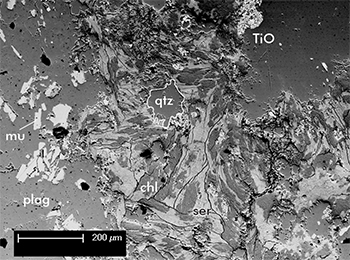
Figure 2d Scanning electron microscope image of sample 1965411, showing a zone of sericite–chlorite alteration, which overprints the primary igneous texture of the rock. (Photo 415925)
Results
Figure 3 Summary of 40Ar/39Ar age spectra obtained by Reid, Jourdan and Jagodzinski (2017). (a) Composite age spectra showing results from sample 1965411, muscovite; and sample 1965413, biotite and K-feldspar. (b) Age spectra obtained from two step heating experiments from two aliquots of sericite from sample 1965411.
Muscovite from SA Geodata rock sample 1965411 yielded an age spectrum that starts at a minimum of c. 1.45 Ga in the initial heating step and then progresses to older ages. Although no plateau age can be calculated, most of the heating step ages are around c. 2.0 Ga (Fig. 3). Analysis of biotite from sample 1965413 yielded a simple step heating age spectrum with the majority of steps yielding ages also around c. 2.0 Ga (Fig. 3). K-feldspar, also from sample 1965413, yielded an age spectrum that varies from c. 1.56 Ga to a maximum of c. 1.86 Ga. As noted by Reid, Jourdan and Jagodzinski (2017), this type of age spectrum is difficult to interpret; however, it most likely indicates a reheating or recrystallisation event that has modified the age distribution within the K-feldspar sometime around or possibly younger than c. 1.6 Ga.
Sericite occurs within a sample of the tonalite as small flakes that form mats of sericite after plagioclase (Fig. 3), and dating of sericite can potentially constrain the timing of hydrothermal alteration (Verati and Jourdan 2014). Two step heating experiments were performed on sericite aliquots from sample 1965411. The age spectra are very similar from both experiments and show a relatively constant age profile, with ages clustering around 1.6 Ga (Fig. 3). Although no statistical plateau age can be calculated, c. 1.6 Ga most likely approximates the age of the alteration event.
Discussion and conclusion
Figure 4 Summary of the thermal history of tonalite from drillhole SH 7 based on the 40Ar/39Ar data obtained by Reid, Jourdan and Jagodzinski (2017).
Argon isotopic data from drillhole SH 7 gives muscovite and biotite ages close to c. 2.0 Ga. The near coincidence of the ages from the two mica species could be a function of a distinct thermal event that affected the tonalite of SH 7 at around this time. Nominal closure temperatures of around 400 °C for muscovite and 350 °C for biotite (Hodges 1991; McDougall and Harrison 1999), suggest that the tonalite cooled below 350 °C by around 2.0 Ga (Fig. 4).
Argon isotopic data from magmatic K-feldspar within the tonalite of SH 7 is consistent with cooling below 300 °C prior to c. 1.86 Ga, the oldest age from the step heating age spectra. The lower end of the age spectra at c. 1.6 Ga is consistent with a thermal event at this time or possibly younger, that has partly reset the K-feldspar. Assuming a typical K-feldspar closure temperature window of between ~150 °C and ~300 °C (McDougall and Harrison 1999), the data suggests cooling to below 150 °C occurred by c. 1.6 Ga.
The sericite argon isotopic data yields consistent ages of c. 1.6 Ga, which was interpreted by Reid, Jourdan and Jagodzinski (2017) as evidence for an alteration event at this time. This suggests that the low-temperature fluid-related alteration of the tonalite in drillhole SH 7 occurred at broadly the same time as the major magmatic, hydrothermal and mineralisation event that affected other portions of the Olympic Cu–Au Province (Skirrow et al. 2007; Reid et al. 2013) and indeed large regions elsewhere in the Gawler Craton (Daly, Fanning and Fairclough 1998; Fraser, Skirrow and Holm 2007; Hand, Reid and Jagodzinski 2007).
K-feldspar and sericite within low-temperature hematite–sericite–chlorite alteration of the tonalite from drillhole SH 7 appear to record the influence of a hydrothermal event at c. 1.6 Ga. This age is identical to the timing of the major mineralisation event that formed the Olympic Cu–Au Province and should encourage future mineral exploration in the vicinity of this drillhole.
Acknowledgements
This study was undertaken as part of the PACE Geochronology program in collaboration with Steve Hogan and Monax Mining Ltd. Miles Davies, former PACE General Manager, is thanked for his support of the PACE Geochronology program. Liz Jagodzinski (GSSA) and Fred Jourdan (Curtin University, WA) are gratefully acknowledged for their work in the original study.
References
Allen SR, McPhie J, Ferris G and Cadd AG 2008. Evolution and architecture of a large felsic igneous province in western Laurentia: the 1.6 Ga Gawler Range Volcanics, South Australia. Journal of Volcanology and Geothermal Research 172:132–147.
Ciobanu CL, Wade BP, Cook NJ, Schmidt Mumm A and Giles D 2013. Uranium-bearing hematite from the Olympic Dam Cu–U–Au deposit, South Australia: a geochemical tracer and reconnaissance Pb–Pb geochronometer. Precambrian Research 238:129–147.
Daly SJ, Fanning CM and Fairclough MC 1998. Tectonic evolution and exploration potential of the Gawler Craton, South Australia. AGSO Journal of Australian Geology & Geophysics 17:145–168.
Fraser G, Skirrow RG and Holm O 2007. Mesoproterozoic gold prospects in the central Gawler Craton, South Australia: geology, alteration, fluids and timing. Economic Geology 102:1,511–1,539.
Hand M, Reid A and Jagodzinski E 2007. Tectonic framework and evolution of the Gawler Craton, South Australia. Economic Geology 102:1,377–1,395.
Hodges KV 1991. Pressure-temperature-time paths. Annual Review of Earth and Planetary Sciences 19:207–236.
Jagodzinski EA 2005. Compilation of SHRIMP U-Pb geochronological data, Olympic Domain, Gawler Craton, South Australia, 2001-2003, Record 2005/20. Geoscience Australia, Canberra.
Johnson JP and Cross KC 1995. U-Pb geochronological constraints on the genesis of the Olympic Dam Cu-U-Au-Ag deposit, South Australia. Economic Geology 90:1,046–1,063.
Jourdan F, Andreoli MAG, McDonald I and Maier WD 2010. 40Ar/39Ar thermochronology of the fossil LL6-chondrite from the Morokweng crater, South Africa. Geochimica et Cosmochimica Acta 74:1,734–1,747.
Lester DR, Ord A and Hobbs BE 2012. The mechanics of hydrothermal systems: II, Fluid mixing and chemical reactions. Ore Geology Reviews 49:45–71.
McDougall I and Harrison TM 1999. Geochronology and thermochronology by the 40Ar/39Ar method. 2nd edn. Oxford University Press, New York.
McPhie J, Kamenetsky VS, Chambefort I, Ehrig K and Green N 2011. Origin of the supergiant Olympic Dam Cu-U-Au-Ag deposit, South Australia: was a sedimentary basin involved? Geology 39:795–798.
Reid AJ and Hand M 2012. Mesoarchean to Mesoproterozoic evolution of the southern Gawler Craton, South Australia. Episodes 35:216–225.
Reid AJ, Jourdan F and Jagodzinski EA 2017. Mesoproterozoic fluid events affecting Archean crust in the northern Olympic Cu–Au Province, Gawler Craton: insights from 40Ar/39Ar thermochronology. Australian Journal of Earth Sciences 64:103–119.
Reid AJ, Smith RN, Baker T, Jagodzinski EA, Selby D, Gregory CJ and Skirrow RG 2013. Re-Os dating of molybdenite within hematite-breccias from the Vulcan Cu-Au prospect, Olympic Cu-Au Province, South Australia. Economic Geology 108:883–894.
Skirrow RG, Bastrakov E, Davidson G, Raymond OL and Heithersay P 2002. The geological framework, distribution and controls of Fe-oxide and related alteration, and Cu-Au mineralisation in the Gawler Craton, South Australia, Part II: Alteration and mineralisation. In TM Porter ed., Hydrothermal iron oxide copper-gold and related deposits: a global perspective, Vol. 3. PGC Publishing, Adelaide, pp. 33–47.
Skirrow RG, Bastrakov EN, Barovich K, Fraser GL, Creaser RA, Fanning CM, Raymond OL and Davidson GJ 2007. Timing of iron oxide Cu-Au-(U) hydrothermal activity and Nd isotope constraints on metal sources in the Gawler Craton, South Australia. Economic Geology 102:1,441–1,470.
Verati C and Jourdan F 2014. Modelling effect of sericitization of plagioclase on the 40K/40Ar and 40Ar/39Ar chronometers: implication for dating basaltic rocks and mineral deposits. Geological Society, London, Special Publications 378:155–174.
Williams PJ, Barton MD, Fontboté L, De Haller A, Johnson D, Mark G, Marschick R and Oliver NHS 2005. Iron oxide-copper-gold deposits: geology, space-time distribution, and possible modes of origin. In JW Hedenquist, JFH Thompson, RJ Goldfarb and JP Richards eds, Economic Geology 100th Anniversary Volume. Society of Economic Geologists, Littleton, CO, USA, pp. 371–405.


